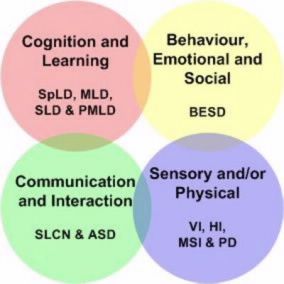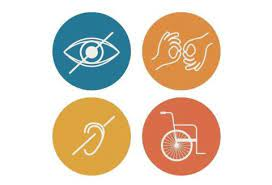We aim to give every pupil the opportunity to develop his/her full potential. We recognise that all pupils have their own individual needs and seek to ensure that each pupil is able to learn, experience success and feel valued in an environment free from obstacles and prejudice.
We are committed to ensuring all pupils receive their full entitlement to a whole school curriculum and make reasonable adjustments for pupils as appropriate.
Mrs Gemma Stangroom and Miss Emms Lewis – SENCos
To view our SEND, Accessibility and Equality Policies, please visit our Policies page.
- SENCo: Gemma Stangroom & Emma Lewis
- Working Hours: Mon-Fri
Questions about your child’s progress
Initial concerns should be raised with the class teacher. SENCO team can be contacted via email – senco@highhalstow.latrust.org.uk
Special Educational Needs
The Special Educational Needs Assistant is responsible for managing the Special Educational Provision across the school. The school operates a vast range of support and intervention for pupils in each year group.
What are the four areas of need?
- Communication and interaction
- Cognition and learning
- Social, emotional and mental health difficulties
- Sensory and/or physical needs


Communication and interaction
Where children and young people have speech, language and communication difficulties which make it difficult for them to make sense of language or to understand how to communicate effectively and appropriately with others.
Children and young people with an Autistic Spectrum Disorder, including Asperger’s Syndrome, are likely to have particular difficulties with social interaction.
Cognition and learning
Where children and young people learn at a slower pace than others their age, they may:
- have difficulty in understanding parts of the curriculum
- have difficulties with organisation and memory skills
- have a specific difficulty affecting one particular part of their learning such as in literacy or numeracy
The term ‘learning difficulties’ covers a wide range of needs, including moderate learning difficulties (MLD), severe learning difficulties (SLD) and profound and multiple difficulties (PMLD). Specific learning difficulties (SpLD) such as dyslexia, dyspraxia and dyscalculia come under this term.


Social, emotional and mental health difficulties
Children and young people may experience a wide range of social and emotional difficulties which present themselves in many ways. They may:
- have difficulty in managing their relationships with other people
- be withdrawn
- behave in ways that may hinder their and other children’s learning or that have an impact on their health and wellbeing
This broad area includes attention deficit disorder (ADD), attention deficit hyperactivity disorder (ADHD) or attachment disorder. It also includes behaviours that may reflect underlying mental health difficulties such as anxiety, depression, self-harming and eating disorders.
Sensory and/or physical needs
Where children and young people have visual and/or hearing impairments, or a physical need that means they must have additional ongoing support and equipment.

Key websites for support and information
Special educational needs and provision can be considered as falling under four broad areas:
- Communication and interaction
- Cognition and learning
- Social, emotional and mental health
- Sensory and/or physical
At High Halstow, all our children’s needs are identified and met as early as possible through:
- observation, assessment, target setting and monitoring arrangements.
- listening to and following up parental concerns and the child’s views, wishes and feelings.
- the analysis of data including baseline assessments and end of Key Stage achievement to track individual children’s progress over time. ∙ reviewing and improving teachers’ understanding of a wide range of needs and effective strategies to meet those needs.
- liaison with schools and other settings on phase and in year transfer.
- exchanging information from other services across education, health, care and the voluntary sector involving an external agency, and the Educational Psychology Service (EPS) as a minimum, where it is considered that a special educational need may be significant and long term and may require more in-depth and frequently reviewed cycles of assess, plan, do and review.
- Pupils’ progress is assessed and discussed within ‘Pupil Progress meetings.
- Class teacher input, through targeted classroom teaching (Quality First Teaching)
- Specific group work with LSAs. This may take place inside the classroom or in an intervention space.
- Specified Individual support from outside agencies such as SaLT, OT or EP support.
- All parents/carers are encouraged to contribute to their child’s education.
- All parents/carers are invited to attend a parents’ evening for their child.
- Parents/carers are invited to attend meetings held in school regarding the progress of a pupil with SEN status.
- Any changes to the provision in place for a SEN status pupil are discussed with parents /carers.
Within school
All teaching staff are responsible for the progress of all pupils. Pupils with SEN will work closely with Class Teachers and Teaching Assistants. Our SENCO, Miss Heard, coordinates provision, carries out observations and screening for pupils across the school.
Our partnerships
At Leigh Academy High Halstow, we work closely with other professionals:
- Marlborough Outreach Team ∙ Fortis Trust Outreach Team ∙ Medway Inclusion Team
- Speech & Language Therapists at MCH.
- Speech & Language Therapists at OWLS.
- Occupational Therapist at MCH. ∙ Educational Psychologist at MCH and LAT.
- Dog Training
- Art and Play Therapist
Your child may work with other professionals in addition to school staff to support their learning.
- ADO – Attention Deficit Disorder
- ADHD – Attention Deficit and Hyperactivity Disorder
- ASD – Autistic Spectrum Disorder
- BESD – Behavioural Emotional and Social Difficulties
- CAF – Common Assessment Framework
- CAMHS – Child and Adolescent Mental Health Service
- COP – Code of Practice
- CP – Child Protection
- EAL – English as an Additional Language
- EHCP – Education, Health and Care Plan
- EP – Educational Psychologist
- FSM – Free School Meals
- HI – Hearing Impairment
- ISR – In School Review
- KS – Key Stage
- LEA – Local Education Authority
- SEN – Special Educational Needs
- SEND – Special Educational Needs and Disability
- SENCO – Special Educational Needs Co-ordinator
- SpLD – Specific Learning Difficulty
- VI – Visual Impairment
Frequently asked questions
We can only screen for dyslexia, and this will provide an overview of your child’s strengths and areas for development. Screening reports are then shared with teachers so they are aware of how to support your child through Quality First Teaching in the classroom.
Yes the school can refer your child for a diagnosis of ADHD, ASD or other referrals needed such as Speech and language. These referrals are completed by the SENCO with support of the pastoral team/teachers. You may prefer to discuss this with your GP as they can facilitate a referral too.
This will be dependent on the level of SEND that your child presents with and support needed at home and at school. The process will require your child to have a personalised plan, if appropriate, that is reviewed at least 3 times and with some specialist involvement. They might be in receipt of Higher Needs Funding – which you would have been informed about via the SENDCo. If you would like to discuss this further please contact the SEND department.
Higher Needs Funding (HNF) levels are dependent on need. The money school receives can be used in a variety of ways to support their needs.
The British Dyslexia Association says:
Dyslexia is a neurological difference and can have a significant impact during education, in the workplace and in everyday life. As each person is unique, so is everyone’s experience of dyslexia. It can range from mild to severe, and it can co-occur with other learning differences. It usually runs in families and is a life-long condition. It is a specific learning difficulty.
We are bound by the Kent (local authority) definition for Dyslexia which can be found in their policy at:
https://www.kent.gov.uk/education-and-children/special-educational-needs/send-strategy/dyslexia-policy
Therefore, if your child has a significant weakness in single word spelling and/or reading (and has had good educational opportunities, teaching and interventions) then they may meet the Kent criteria for dyslexia.
For us to gain a better understanding of your child’s literacy skills (this is where weaknesses are most evident) we can run a ‘strengths and weaknesses’ screener. This identifies a possible dyslexic profile or dyslexic tendencies. It helps us identify weaker ‘cognitive’ skills such a phonological processing (being able to identify and manipulate the sounds in words) which can signify dyslexic tendencies.
We would then want to gather information from you and the class teacher, and look at a child’s work. A screener is a limited snapshot of a child’s ability – it is important we gather a full picture and look at interventions over time too.
Therefore, we can screen your child for a possible dyslexic profile and to help us identify possible interventions, but this is not the same as a dyslexia diagnosis. We cannot diagnose dyslexia in our school. This would need to be an independent, certified assessor. It is an educational diagnosis that is life-long and results from high levels of psychometric testing that staff in primary schools are not qualified to use. A diagnosis is recognised under the Disability Discrimination Act (2010), permits an older child to have access arrangements at secondary school and adaptations in the workplace. This is private and comes at a cost. Assessors look for a discrepancy between a child’s general ability (like their IQ) and a child’s literacy skills.
Our teachers have dyslexia awareness training and can make adaptations to their teaching so that your child can access the curriculum like their peers. Very often, good strategies for dyslexic children are good for all children. Our focus is always on good teaching and good interventions, rather than the label.
Dyscalculia is a specific maths difficulty. It is inherent rather than just being ‘weaker’ at maths. A child will display intrinsic difficulties with their quantitative understanding of number at a basic level – i.e. show them 3 counters, then 6, and they could not quantify that one set was larger than the other, nor could they give sensible estimates for each quantity.
This would be a child with very poor conversion of number. We have very few children where this has been identified. We cannot diagnose dyscalculia. This would fall to an Educational Psychologist or a certified assessor, and would likely be a private educational diagnosis.
Dyscalculia is specific – so a child is likely to be average in many aspects of schooling, apart from maths. It probably could not be considered if a child has general learning difficulties, a bit like dyslexia.
The important thing is to understand a child’s mathematical gaps and work with them through intervention and class-based support.
This is also called Developmental Coordination Disorder (DCD).
This affects a child’s gross and fine motor skill development and sometimes their sensory profile.
It can arise with other specific conditions – dyslexia, ASD, ADHD etc.
Does the teacher see functional difficulties with a child’s self-care skills? E.g. changing for PE, gross motor coordination in PE, fine motor skills – scissor and pen skills, knife and fork skills, handwriting? Does the child appear clumsy and less able to coordinate their movements than peers? Struggles to throw and catch in PE? We need to evidence 3 different functional areas that the child struggles with.
If we see the above, then the child probably has had/needs intervention anyway.
A DCD diagnosis is a Health diagnosis and requires a referral to an Occupational Therapist. The OT service needs to see that the school have put in appropriate interventions such as BEAM or Clever Fingers for up to 50 sessions, before a referral can be made. Therefore gathering what is needed for an OT referral can take some time.
Once the referral is made, the wait can be 3-4 months before parent and child is invited to clinic (if the referral criteria is met). The OT can then identify strengths and weaknesses and help parents and school develop a programme or strategies that will help the child compensate for their motor weaknesses.
We can run a speech link or languagelink screener. This identifies the speech sounds that the child might be muddling/substituting, or which areas of language (e.g. instructional, vocabulary, concepts, pronouns etc) they are weaker with. It helps us determine how severe a problem there may be, but it is a computer-based snapshot and it is important to talk to you as a parent and glean information from the teacher.
It can also help us identify additional interventions your child may need, which will also provide evidence to help us make a referral to the NHS speech and language therapy team, if intervention does not have impact.
Some children experience a speech or language delay – the difficulty is likely to resolve itself or ‘catch up’ or could be a disorder, which is where more specialist intervention may be needed.
We know that children with speech and language difficulties may go on to have difficulties with learning, particularly literacy, though this is not always the case.
Very few of our children need 1:1 support to make good progress.
The vast majority of children learn when teaching is responsive to their needs and work is well differentiated. Class TAs are used to help scaffold children’s learning if they find things more tricky.
Sometimes, 1:1 support can also lead to dependency on an adult (I can only learn when an adult sits next to me) and we all want your child to be an independent learner.
In some situations, we may need to apply for funding to provide a child with some key person/1:1 support. This is called High Needs Funding, and is for children that require bespoke approaches. Applications for this high level of support are stringent and require lots of plan/do/review, evidence and proof of what is spent already on a child’s support.
Please note that an EHCP does not ‘come with’ funding attached or a certain number of hours of 1:1 TA support. This happened in the old system of ‘statements of SEN’, but is not the case now.
Parent guidance for HNF available on the Kelsi website.
We would encourage you to read the Inclusion policy on our website.
The school is bound by a definition of Special Educational Needs as set out by the legal framework, the SEN Code of Practice (2014).
A child or young person has SEN if they have a learning difficulty or disability which calls for special educational provision to be made for him or her.
A child of compulsory school age or a young person has a learning difficulty or disability if he or she:
has a significantly greater difficulty in learning than the majority of others of the same age, or
has a disability which prevents or hinders him or her from making use of facilities of a kind generally provided for others of the same age in mainstream schools or mainstream post-16 institutions
For children aged two or more, special educational provision is educational or training provision that is additional to or different from that made generally for other children or young people of the same age
Being SEN or being placed on a school’s SEN register is not because a child receives a diagnosis of a condition – it must be because educational provision is consistently different for them to enable them to make progress in their areas of difficulty. Parents must remember that if their child has a Health condition or diagnosis, that this probably falls under the 2010 Equality Act and means that any school or educational provider must make reasonable adjustments for them, whether they are SEN or not.
We support children as their needs arise and teachers adapt work and their teaching delivery as necessary, maintaining interventions for those children that need something additional. Being SEN or not SEN does not change this.
If your child moves onto the SEN register they will be classed as ‘SEN support’ and their teacher will identify long term Outcomes for them to work towards.



